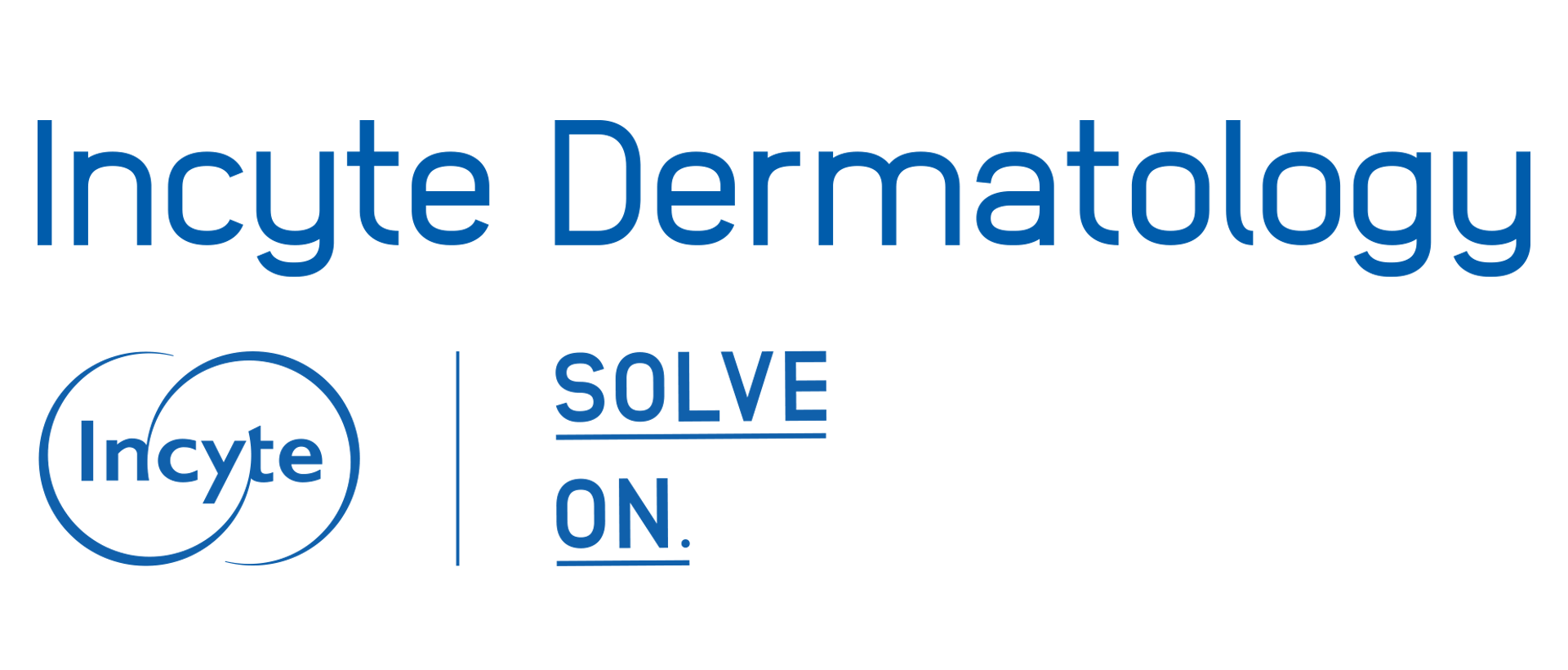The profound dermatological manifestations of COVID-19: Part III

By Warren R. Heymann, MD
April 8, 2020
Vol. 2, No. 14
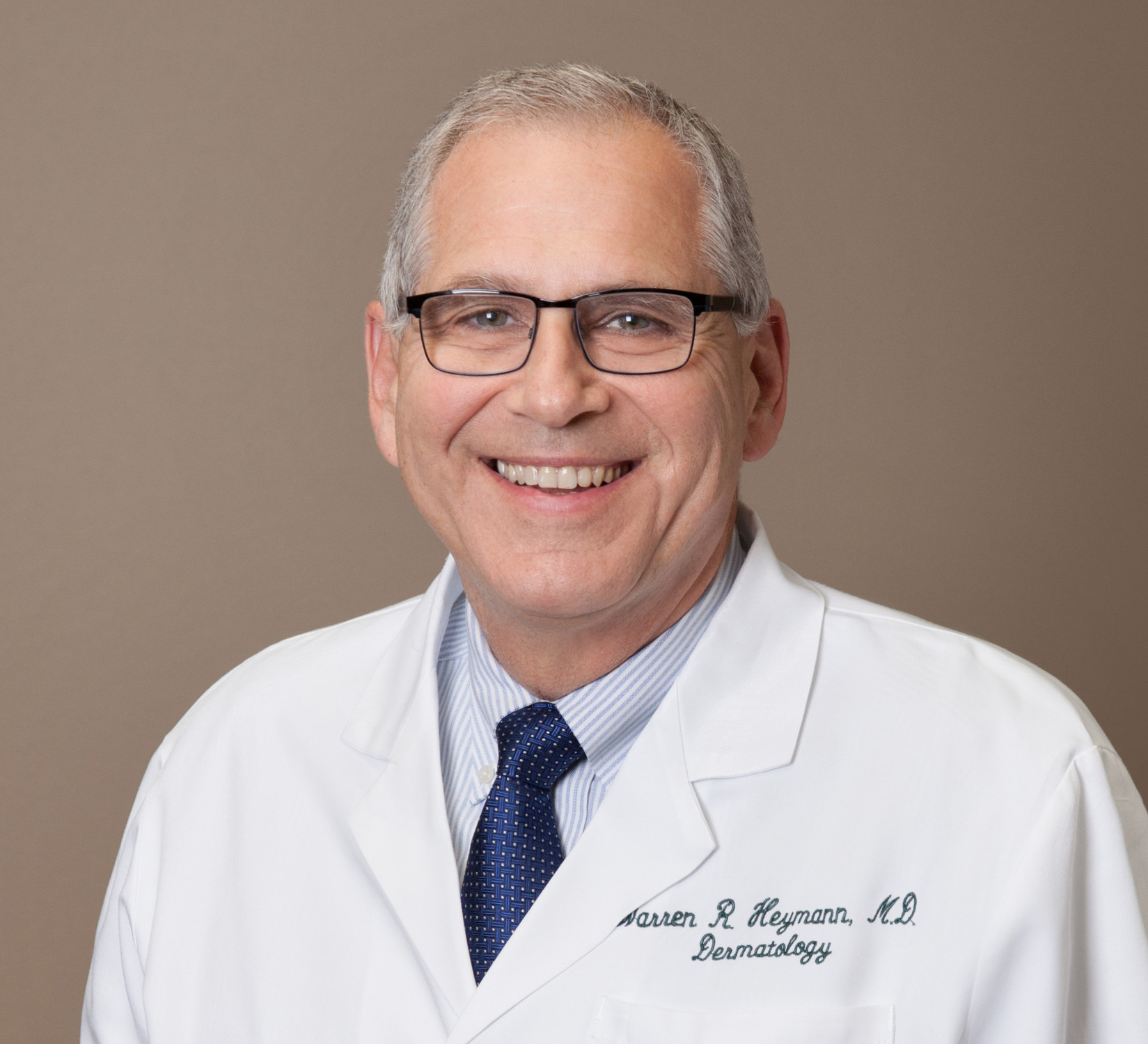
Disclaimers: This commentary was written on April 5, 2020 for a publication date of April 8, 2020. The issues related to the COVID-19 pandemic are changing by the millisecond. The content included in this commentary may no longer be factual or relevant by the publication date. The reader is encouraged to stay abreast of developments via the CDC and local government and institutional health care authorities. The AAD has instituted the valuable resource “Protecting your patients and practice during the COVID-19 outbreak.” This commentary, like Part II of this series, represents my opinion, not that of the AAD.
As I am writing this commentary, New York has yet to hit the apex of the COVID-19 curve, and the surge is just days away from our area in the Greater Delaware Valley (Southern New Jersey/Philadelphia). The next two weeks are likely to be devastating for the populace and all those attending to the needs of the infirm. To say we owe these courageous people our debt of gratitude is a vast understatement. They are real heroes.
Part I of this series defined the COVID-19 pandemic in scientific terms; Part II was devoted to the changes in our practice. Part III is a personal reflection on the crisis.
Regarding our practice itself, people are finally getting the message for social distancing. The number of patients seen in the office has trickled to a few, and mostly with legitimate problems that cannot wait (severe dermatoses, abscesses requiring incision and drainage, rapidly growing and painful tumors). Each physician is just going in once or (at most) twice a week at our two offices for very limited hours.

Like most practices, teledermatology has now taken a predominant role in ours. Even so, at most I have done a handful (about half a dozen) on my busiest day. There are constant discussions about what is best — our EMR, FaceTime, Skype, or the new Doximity video. No matter which one is chosen, what would typically be a short visit in person becomes tediously longer (as there is no MA to help with the note, find the pharmacy, etc.). There have been some cases where I really have had difficulty assessing a rash, an example being a young woman in her mid-trimester of her second pregnancy. Did she have bites, folliculitis, early polymorphic eruption of pregnancy, or a viral exanthem? Should she not get better with betamethasone, I will need to see her in person. Of course, there are some humorous moments. An elderly woman was worried that she had breast cancer after noticing a rash on her left areola a few days earlier. We FaceTimed.
“Dr. Heymann, what do you think?”
“Mrs. Johnson, you have a lovely chandelier! Can you aim your phone so I can see your breast?”
“OK! Now what is your opinion?”
“I was never fond of shag carpet. I haven’t seen that since the 1960s! Can you please try to show me your breast?”
She finally got it right. Just nipple eczema. Back to take betamethasone and call me in the morning.
The bottom line is that there is no way we can ever do enough teledermatology visits to compensate for real-life visits where multiple problems can be dealt with and procedures performed. There is no 25-modifier with teledermatology. For the foreseeable future it will have to suffice.
I never heard of Zoom until a few weeks ago. Zoom is the appropriate name because it has zoomed into my reality — for our faculty meetings (and services for my synagogue). We anticipate a Zoom grand rounds in the coming weeks.
There are so many areas of concern. Foremost is the health of our country. Even the conservative estimate of impending loss of life is unfathomable. While hope is not a plan, that does not mean that we shouldn’t pray for wise decisions from our leaders to do everything humanly possible to avert disaster.
From a parochial, dermatological perspective, I worry about several issues.
We are asking patients to delay their appointments for non-urgent issues. How long will it be before some of those problems become urgent? What mixed messages are we sending people? For example, we have finally gotten many to understand the concept that changing moles must be assessed as soon as possible — now we might be saying that it is OK to wait a few weeks (unless teledermatology demonstrates a genuine melanoma, where I trust most of us would get the patient in during the pandemic).
As stated in Part II, I view our role as dermatologists to see urgent and emergent cases to keep these patients away from the emergency room. That role is changing in areas of dire need. Please read “With virus surge, dermatologists and orthopedists are drafted for the E.R.” by Somini Sengupta (New York Times, April 3, 2020). Other than dermatological consultations, I have not worked in an ER or ICU in 40 years. I might be more detrimental to a person’s health than the coronavirus itself.
Buerhaus et al offer a sensible perspective on utilizing senior physicians (and younger colleagues) in their editorial “Older clinicians and the surge in novel coronavirus disease 2019 (COVID-19)” published online in JAMA, March 30, 2020: “It is reassuring that large numbers of older nurses and physicians are caring for patients today. These clinicians have decades worth of knowledge, experience, and relationships with coworkers that will be needed now more than ever when large numbers of patients are hospitalized with COVID-19. These clinician leaders are an essential and vitally important component of many organizations, especially because many of these older clinicians have experience with disasters, triaging, decision making, and managing staff and resources under times of great stress. Conversely, should these older nurses and physicians become infected and required to stay home, or if they become patients, the ramifications could be significant, not only in terms of the loss of their clinical expertise and presence when it is needed the most, but the loss of leadership, judgement, and maintaining morale.” I concur with their conclusion: “As the public, government, and the health care workforce prepare for what could be extraordinarily challenging weeks and months ahead, thought should be given on how to wisely use all health care resources, including the nation’s nurse and physician workforce — from students to the most seasoned.”
Just as our clinical load has greatly diminished, so has that of our residents. They are doing a marvelous job restructuring the educational program for our students and are participating with our teledermatology cases. If this goes on too long, however, I am concerned that the dearth of clinical cases — medical and surgical — will adversely affect their education at this crucial time in their training. Virtual cases can only go so far. Once this situation eases, we will need to make sure that that every effort is made to compensate for this lull in their clinical activity.
I would be remiss in not acknowledging the financial impact on all practices — private or academic. Perhaps there are some institutions with large endowments that can weather the upcoming economic tsunami. The following is an excerpt from an article in today’s Philadelphia Inquirer (“Virus hitting small practices hard — with patient visits in steep decline, they look for ways to weather the financial storm” by Harold Brubaker, April 5, 2020):
“It’s a huge decrease,” said [Joseph] Laskas, who is one of 10 doctors at Dermatology Ltd., which employs 53 in offices in Media and Glen Mills. “For all intents and purposes, the business is closed, except for everybody’s still on payroll.” The practice is looking at every angle for financial relief and wants to keep paying employees. “So far we’ve been doing that, but it can’t go on forever,” Laskas said.”
I imagine that most practices have applied for a loan via the “Paycheck Protection Program” in the “Keeping American Workers Paid and Employed Act”. I am not an economist, but should the situation continue beyond June 30, as is likely (in my estimation), this will probably just be the first step of ongoing supportive economic initiatives.
Now for the purely personal.
As much as I want to keep up to date with the news, listening non-stop is anxiety-provoking and does not help my state-of-mind or well-being. Twice a day is enough to learn that the number of COVID-19 cases and related deaths are skyrocketing, unemployment is hitting staggering heights, and that the stock market is having its daily convulsions.
Being able to concentrate on projects for a few hours at a time — such as working on the next edition of Treatment of Skin Disease, on DWI&I, and “A Clinician’s Perspective” for the JAAD, provides a worthwhile distraction and sense of purpose.
There have been several upsides to this crisis. I have enjoyed long FaceTime conversations with old friends that, in our previously busy lives, I would only connect with briefly. We have meals at home — usually my wife and I are so busy, we would eat out literally all the time. I started doing domestic chores that were always previously relegated to outside help. I actually enjoy vacuuming and scrubbing the bathrooms — I get a unique sense of satisfaction when the toilet sparkles! (If patient volume does not return, perhaps I’ll clean the office. Maybe you will hire me, and we can also discuss some cases at the same time!) For 38 years I have known that I love my wife — now that we are together virtually all the time, that love has been affirmed. She really is my life partner, and I find warmth, peace, and solace in her presence.
Last night I caught the scene in the The Ten Commandments where Moses and the ancient Hebrews are huddled in their home as the angel of death passes over Egypt, killing the first born of the land. How surreally apropos to today’s plague. As Passover and Easter is celebrated this week — by Zoom (a “zeder” instead of a seder), let us all give thanks that we are here and confronting this crisis together spiritually, if not physically. On behalf of the editorial board and staff of DWI&I, I wish you the happiest of holidays. At the end of the seder, participants say “Next year in Jerusalem!” This year, I’ll be concluding with “Next year, together, in person!”
Our Expert’s Viewpoint
Misha Rosenbach, MD
Associate Professor of Dermatology
Hospital of the University of Pennsylvania
It is always an honor and privilege to be asked to add "commentary" to a piece by Warren — and a challenge, as he’s a brilliant writer and person, and his humanity comes through along with his scientific teachings.
COVID-19 will be a monumental tragedy with a tremendous loss of life and is the greatest health care challenge of our time. We have already felt the shocks as it starts, but as Warren notes, the surge is just beginning in New York — and the peak will continue for weeks. Patients are asymptomatic for approximately 5 days (though still shedding virus and spreading COVID-19), and then sick for a period of time — often as long as 2 weeks. At some point within that period, some patients are sick enough to require hospital admission (which can also be lengthy), and some of those require intensive care support (and some of those require ECMO) — both of which can require prolonged admissions. The lack of widespread testing (or no screening) across the U.S. means we do not yet have a handle on accurate numbers of cases, but with each patient on average transmitting the infection to 2-3 others, and that prolonged "lag," we know the tsunami is building and the waves of patients requiring our help are on the horizon. When the surge comes, it will continue — this is not a day of heavy admissions, but a month of each hospital being pushed to the brim, beyond capacity, filling overflow areas, with patients with COVID-19 who need support and care.
Warren’s prior pieces, and my commentary, have touched on issues pertaining to the critical shortage of personal protective equipment (PPE) — note that Warren’s photo on this piece shows him in a regular, non-N95, surgical mask, as is appropriate. The national news has appropriately highlighted a shortage of vents. What is less well discussed is the shortage of intensivists, experienced ICU nurses, respiratory therapists, and the other personnel who care for those critically ill patients. As Warren turned this piece toward the personal, I would encourage everyone to remember that even if manufacturing of ventilators picks up, there is still a dearth of experienced providers to care for these critically ill patients. Beyond that, we are just starting to realize there is a shortage of medications required to comfortably sedate patients ... and concerns about potential shortages of medications that are essential in end-of-life care focused on comfort, such as specific benzodiazepines and/or opiates. The steps needed to appropriately rise to the challenge that COVID-19 poses require an evidence-based, scientific, and thoughtful approach, with anticipation and proactive planning.
Some of the methods aimed at addressing the shortage of personnel, in New York at least, have included discussions of graduating medical students early (though this is controversial, and in the last 24 hours the ACGME has put out a statement about this type of decision) and requesting volunteers return to work from retirement (notably, those providers may be at higher risk of more severe infection should they acquire COVID-19 through patient care) or from other fields. A statewide alert went out on mobile phones this week asking for healthcare personnel to help New York’s response. There are efforts underway to create "mobile response units," where providers (and gear) can move from one hot spot to another, as the pandemic rages through each location. Again, as Warren’s piece is more personal, it is important for this commentary to reflect that as well — another source of personnel is the redeployment of subspecialists, including dermatologists, into direct patient care roles aiding in the triage and management of patients with COVID-19. This has already happened in New York, Boston, and here in Philadelphia. Note, too, New York City is one of the wealthiest places on Earth. As we watch the tragedy that is unfolding there due to unnecessary delays in developing, adapting, and scaling up diagnostic testing capabilities, I would encourage everyone to give a thought for crowded cities in Brazil, Mexico, India, and elsewhere, where the population density is often greater than in New York, with fewer resources, and in many places a lack of easy access to necessities for combatting COVID-19, such as running water.
Warren has pointed out some of the secondary consequences of COVID-19, including appropriately drawing attention to the challenges faced by social distancing, "flattening the curve," and necessary closures of businesses and limitations on non-essential visits. This has profound consequences to dermatologists, many of whom are in small groups or even solo practice. As Warren noted, the AAD has an Ad Hoc Task Force focused on Covid-19, and the AAD membership page is regularly updated with helpful information to navigate loans, financial support, guidance on new rules and regulations, integration of telemedicine and appropriate tools and billing, and more. (Conflict of interest disclosure: I am a member of that task force, though I am writing this piece on my own and without representing the Academy or any formal organization).
In the U.S., the next few weeks will be critical. COVID-19 is already the third leading cause of daily death in the country, and with exponential growth, April will be a deadly month. It will be hard to watch the numbers rise — but important to remember that each death is not a statistic, but a person, with a family, and a story of their own. Once this calamity passes, it will be necessary to critically examine how our country’s preparedness and response to this crisis has faltered, and how we should be ready for any future pandemics. Equally as important, if not more so, is that the heroic health care workers and ancillary staff (registration, environmental services, medical assistants, physical therapy, respiratory therapy, nursing, and many more) who are giving their all to provide the best possible care for each and every patient during this overwhelming period, are remembered as heroes.
All content found on Dermatology World Insights and Inquiries, including: text, images, video, audio, or other formats, were created for informational purposes only. The content represents the opinions of the authors and should not be interpreted as the official AAD position on any topic addressed. It is not intended to be a substitute for professional medical advice, diagnosis, or treatment.
DW Insights and Inquiries archive
Explore hundreds of Dermatology World Insights and Inquiries articles by clinical area, specific condition, or medical journal source.
All content solely developed by the American Academy of Dermatology
The American Academy of Dermatology gratefully acknowledges the support from Incyte Dermatology.
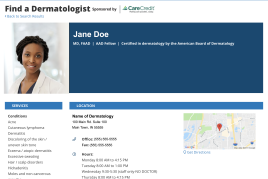 Make it easy for patients to find you.
Make it easy for patients to find you.
 Meet the new AAD
Meet the new AAD
 2022 AAD VMX
2022 AAD VMX
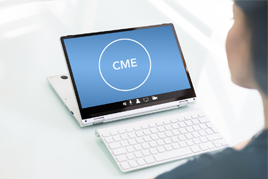 AAD Learning Center
AAD Learning Center
 Need coding help?
Need coding help?
 Reduce burdens
Reduce burdens
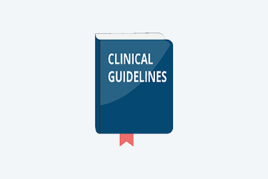 Clinical guidelines
Clinical guidelines
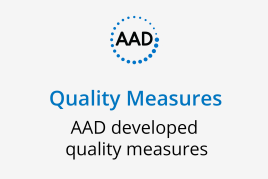 Why use AAD measures?
Why use AAD measures?
 Latest news
Latest news
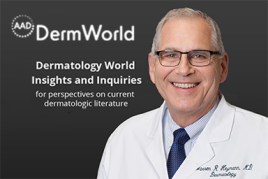 New insights
New insights
 Combat burnout
Combat burnout
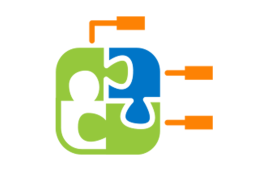 Joining or selling a practice?
Joining or selling a practice?
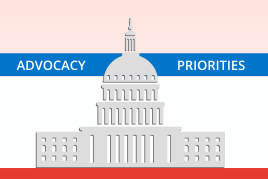 Advocacy priorities
Advocacy priorities
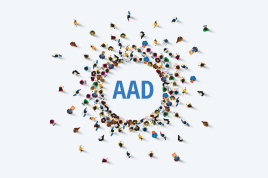 Promote the specialty
Promote the specialty
